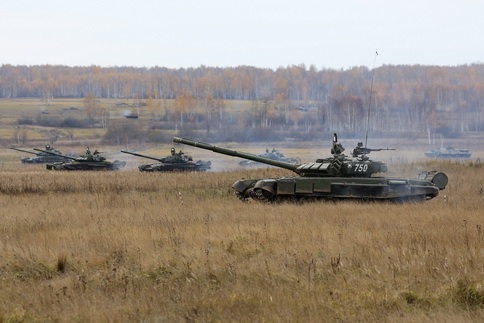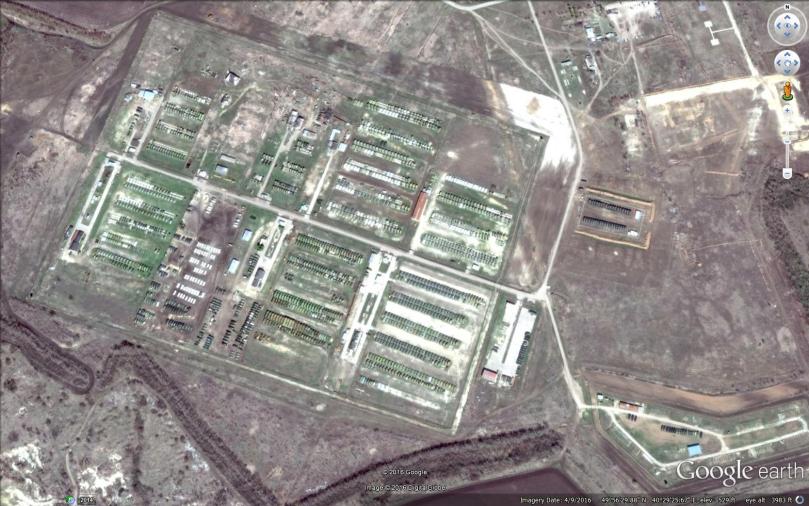In a previous post I had not discussed that alongside the three announced divisions around Ukraine, Russia’s General Staff also planned a fourth in Chelyabinsk oblast. This division has at times been announced as part of “Russia’s response to NATO” though its location naturally tells us otherwise given it is right across the border from Kazakhstan. First news of it came in late January 2016. Adding to the spread of divisions is the recent announcement on August 23rd from a Ministry of Defense meeting that there is another division in the works for 2018. A press report from the recently held meeting revealed that the General Staff intends to form a coastal defense division on Chukotka.
I’ve compiled the history and background of these changes from a few news announcements, including posts from colleagues and other blogs on the subject, such as bmpd, eagle_rost, and one of the better takes out there written by Aleksei Ramm on Defence.ru
7th Armor Brigade’s T-72B tanks

The 7th Independent Armor Brigade in Chebarkul (Chelyabinsk oblast) will be converted into a division – this unit is part of the Central Military District. This brigade is one of the two remnants of the 15th Tank Division, which was moved back to Russia form Czechoslovakia in 1991. Later in 2004 the division was disbanded, leaving two regiments that would become the core of a new division, the 34th, headquartered in Ekaterinburg. During the 2009 reforms, which led to the consolidation, displacement or disbanding of numerous units across Russia, all divisions were turned into brigades. Hence the 34th was broken into two brigades, the 28th Motor Rifle which stayed in Ekaterinburg, and the 7th Armor in Chebarkul. The region hosts a sprawling military base not far from the border with Kazakhstan.
The division’s structure will include the following elements: 1 motor rifle regiment, 1 self-propelled artillery regiment, 1 air defense ‘division’, a reconnaissance and an engineering battalion, along with several supporting units of smaller size. It was not officially stated, but we should venture an assumption that the tanks of the 7th will be included in a tank regiment as part of the new division. Suffice it to say, this does not match a six regiment Soviet division, though it looks close to the 2nd or 4th half divisions which also have two regiments. In Aleksei Ramm’s view, because this unit only has one motor rifle regiment and an air defense ‘division’ in place of a full regiment, it is simply an expanded combined arms brigade. It’s chief accomplishment is a larger staff and a substantially larger artillery compliment than a normal brigade would have. There is no timetable for completing this unit formation, but I suspect late 2017 is a good date to go by given the timetable for the other divisions announced.
A recap of why Russia is recreating divisions: The concept is to have an organization with the staff and logistics base that would allow brigades to send tactical battalion groups to the front, making the division a management rung below that of the combined arms army, i.e. Military District -> Combined Arms Army -> Division HQ-> regiment or battalion tactical group. Brigades are too small to take in battalions from other brigades and command or support them. Hence divisions may prove the most useful tell of where the Russian military expects the need for task organized formations. Russia’s force structure remains in an experimental state, absorbing the experiences of the last two years, but its becoming clear that brigades remain the force generating component while divisions are the task organizing command and support structure for expected contingencies.
Turning to the far east – a new division on Chukotka is a bit of a surprise since it is about as remote piece of real estate for a base as one can find in Russia. This will not be a combined arms division, but likely a coastal defense unit integrating various missile fires and artillery units under one command. The principal motivation was the decision back in July 2015 to create a unified coastal defense system from Primorye to the Arctic. It’s objective is to effect “sea control” (or in reality sea denial) over the littorals by Kuril Islands, the Bering Strait, and defend Russia’s ballistic missile submarines stationed in the Pacific Fleet. Of note, two of Russia’s new Borei-class SSBNs have arrived to start replacing the rather ancient Delta IIIs stationed there.
Abandoned military base at Gydim. Photo from basov chukoka.

According to the announcement the Pacific fleet had conducted a survey from April to June of this year of two Kuril islands for suitability to host garrisons, namely Matua and Paramushir. It’s unclear how that statement connects to the formation of the division in Chukotka, except that it will likely extend coastal defense from the Kurils all the way to the Bering Strait. Russia has already invested heavily in reinforcing the A2/AD systems on the Kuril Islands since that chain forms the outer boundary of the SSBN bastion in the Pacific.
Another photo of abandoned ‘Gydim’ an unofficial name of the military town by Anadyr where once nuclear warheads were stored, presumably in summer time, when it is more ‘cheerful’ (my implication is not that Gydim will be reactivated, or Anadyr will once more help host the division, but simply to speak to the efficacy of establishing bases in these remote regions). Photo from Alexander Belenkiy’s blog.

Some history offered by bmpd blog on Russian military presence in Chukotka: under Stalin in 1947-53 Chukotka hosted the 14th Army, but this unit was disbanded promptly after his death. Subsequently in the 1980s the 99th motor rifle division was based here, although it was only manned at cadre levels. That unit was eventually disbanded in 1994. A Russian military base in Gydim has become a ghost town, like many other Soviet towns and bases sprawling across the country’s less inhabitable regions. It is an attraction for photo adventurers who are drawn to abandoned buildings and Soviet military infrastructure. Photos of what was left of Russian military presence on Chukotka are illustrative of how expensive, and arguably wasteful, establishing a sizable contingent there would be.
Although it may have a stronger rationale than the string of bases in the Arctic, this plan seems to entail burying substantial money into the snow. Those stationed on Chukotka will be able to reflect positively only on the fact that they were not stationed on Novaya Zemlya. More than likely this new coastal defense division will also be presented as ‘Russia’s answer to NATO’ and in Western press be characterized as militarization of the Far East. In reality it will further integrate various artillery and missile units in the region, and perhaps extend the A2/AD layer north of the Kuril island chain towards the Bering strait.
Recommended: Aleksei Ramm’s piece here, BMPD piece on the division in Chebarkul and Chukotka, also eagle rost. Russian defense policy is always a good read.
















